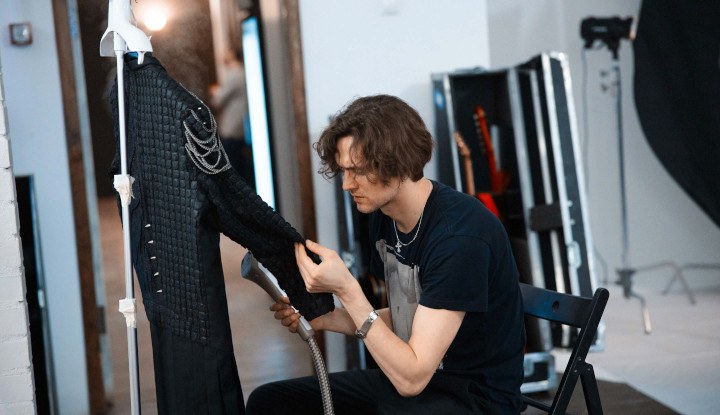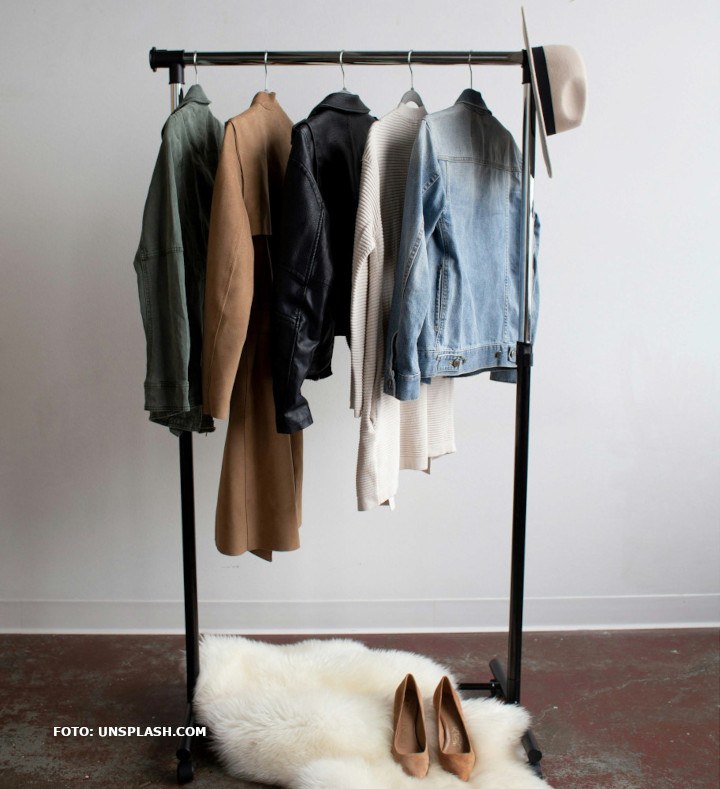WORDS: MIA MEDAKOVIĆ
INTERVIEW: RUSLAN KOZLOV
PHOTOS: FROM THE PRIVATE ARCHIVE
RUSLAN KOZLOV WAS BORN ON JANUARY 1, 1989. HE HAS BEEN INVOLVED IN ART SINCE HE WAS A CHILD AND WANTED TO BECOME AN ARCHITECT OR TAKE UP ICON PAINTING, BUT AT THE AGE OF 14 HE BECAME INVOLVED IN ATHLETICS (110-METER RUN WITH HURDLES). HE LEFT HOME AT THE AGE OF 15 FOR MOSCOW IN THE HOPE OF BECOMING A PROFESSIONAL ATHLETE AND JOIN THE COUNTRY’S OLYMPIC TEAM. DUE TO INJURIES, HOWEVER, HE HAD TO QUIT AND DECIDED TO STUDY THEOLOGY AT THE UNIVERSITY WHERE AT THE SAME TIME HE ALSO CONTINUED TO STUDY ART. ABSURDLY ENOUGH, HE WAS EXPELLED FROM THE UNIVERSITY FOR JUST TAGGING A WALL. HE THEN MOVED TO ST. PETERSBURG WHERE HE TRAINED AS A COSTUME DESIGNER, BUT THAT IS ALSO HOW HIS CAREER AS A STYLIST BEGAN.
How did you become a stylist?
While studying as a costume designer in St. Petersburg, I worked as a model for a fashion brand. During that time, I became friends with the owner, and I was hired as a second designer in their experimental atelier. At that time, I realized that being a designer wasn’t for me and I was given the opportunity to try myself at being a stylist and art director. For the first shoot, I was both the model and the stylist.
The shoot was very successful and to this day, I still consider it relevant, and this is how I got more involved with that side of fashion.
What’s in your business description?
The role of a stylist encompasses a dynamic set of responsibilities that adapt to the specific demands of the task at hand. While there are no rigid guidelines dictating actions or mandatory steps, maintaining impeccably clean and well ironed clothing is a constant requirement. The versatility of the profession becomes evident when considering what the shoot is all about.
For instance, when organizing a fashion catalogue, a stylist must exhibit qualities such as perseverance, agility and unwavering commitment to client satisfaction. Typically, an art director oversees the pre-approved looks, and the stylist’s role involves enhancing the ensemble with intriguing elements, often through accessories, while ensuring alignment with the brand’s vision. While suggestions for experimentation are welcomed, tact and respect for the established vision are crucial.
In the realm of private photography, the stylist should be attentive to both the client and the model. It’s imperative to avoid imposing personal preferences or a rigid vision of beauty, prioritizing instead the emphasis of the subject’s style with finesse. Creative photography provides an avenue for self-expression, allowing the stylist to collaborate closely with the photographer in steering the artistic process.
One facet of the stylist’s responsibilities, although not always a favorite, is the exploration, selection, and acquisition of clothing and accessories from stores and showrooms. This task demands an acute awareness of current trends and an ability to align choices with the envisioned aesthetic.
In summary, a successful stylist embodies qualities of stress-resilience, composure, and sociability. A cheerful and amiable personality is particularly advantageous in a profession where positive collaboration and flexibility are paramount, as the ability to adapt to diverse situations with enthusiasm greatly contributes to overall success.
What does a stylist’s work look like during a photo shoot?
The role of a stylist in a photo shoot is akin to a high-speed race spanning 3-8 intense hours, requiring meticulous preparation and coordination. The stylist’s day begins early, at least an hour before the shoot, setting up and steaming clothes to ensure everything is ready for photography. While creativity is often delegated to assistants, the stylist finds therapeutic value in tasks like steaming.
Following this, the stylist collaborates with the creative team—whether the art director, producer, or client—to align the looks with the shoot’s vision. Once approved, the stylist dresses the model, adding accessories, and actively engages in the shoot. In the frame, the stylist’s role involves maintaining emotional rapport with the model and meticulously overseeing clothing details. Similar to how a makeup artist ensures the model doesn’t “shine”, the stylist manages folds, angles, and corrections in tandem with the photographer to achieve the desired visual outcome.
You have been living in Serbia for two years. How have you adapted your work?
To be honest, I didn’t adapt my work in any way. The interaction mechanics are the same. I think that people all over the world want to be beautiful and happy, and a job well done is a guarantee of success anywhere in the world.
True, I learned the Serbian names of things and sometimes duplicate them in English. Otherwise, I honestly don’t feel any difference. A smile and politeness open all doors and hearts.
Who do you collaborate with the most?
At this stage of my life, I work more as an art director and producer of video and photo shoots. Therefore, I can choose when and with whom to work. I really love private shoots because it makes people truly happy. Here you can focus on the personality and reveal it together with the photographer. I love filming with actors and musicians – they are always incredibly charismatic and popular, but at the same time I always see them exclusively as people. If we talk about the language environment, right from the moment I arrived in Belgrade, I started working mostly with Serbian clients and only after a year I began to “reach out” to Russian customers. Paradoxical but true.

What kind of style is trending today?
Today, the so-called “Instagram” style is trending. This applies to both men and women. Instagram shapes people’s preferences. Most often young people and especially girls become prominent representatives. It’s difficult to say exactly what it is, but as a rule, there is a clearly emphasized sexuality for girls, and for guys, I would call it a “new free office” – an ennobled version of the skate boy.
In general, all trends come from the Fuse and their celebrities, and the whole world, to one degree or another, follows these trends; sometimes curious and sometimes provocatively ridiculous. But these are all fashion and social phenomena, so this is our life and we love it no matter what it is.
What is stronger today: individual or collective style?
I believe in the individual and I believe that individuals are stronger than the masses. As I noted above, today mass products are in fashion and this applies not only to clothes; food, films, devices – everything is popular, and many people follow whatever is most popular these days. I can’t say this is good or bad. I think that anyone who needs to find their social group can easily find it by going to stores in the mass market segment, where all problems are now solved at quite affordable prices. In such stores you can find anything from a basic wardrobe to some creative class delights. Any person who wants to stand out can also solve this without too much difficulty by dressing in either designer, vintage or hand-sewn clothes. The most important thing is to be a happy person, and whether or not one chooses a mass approach to clothes or not is not so important.
What would you recommend about how a modern woman aged 30-45 should look like in Serbia today?
This is already a question with an asterisk. As always, I would go from the individuality and goals of a particular image.
If this is an everyday look, then you need to wear comfortable clothes that will highlight your individuality. For some it’s a gray checkered trouser suit, and for others it’s a faded leather jacket and bright accessories. I really like the way Serbian women dress. Boldly, brightly, emphasizing your figure, with charm and a certain audacity. But to be honest, I would always recommend classic silhouettes, they’re always in style and have a certain magic…
In what direction is style and fashion moving?
I think that fashion is toiling around like a child lately and sometimes it works and sometimes it is just an experiment!
Design now is a game with fabrics and textures but not much more.
Every season we see the same trends that include bright colors, neutrals, appliqués, but there is no truly worthwhile work with the form.
The silhouette these days is mostly flat, utilitarian and the whole design boils down to replacing the cargo pocket with a patch pocket and that’s it; add to that some shine from the 80s – and you’ve got yourself a new collection.
We also see an endless carousel of memories, the 90s and 2000s with their fit have been fashionable for the last few years, especially thanks to social media like TikTok and now’s the time for some 2010s revival, which is not great news….
It is possible that something worthwhile will emerge from experiments with street fashion, but… truly great things are born in difficult times. When big shifts happen they give birth to a new way of looking at things. The First World War and the Dior silhouette, Cardin in the Second World War with his black tights, the sexual revolution in the USA with hippies and cargo pants as a response to the exquisite French classics of Yves Saint Laurent…
Balenciaga believed that working with form comes first; the author of 7/8th length and much more, and I completely agree with this point of view; form is everything!
The theme of the January issue of the RYL magazine is “How you speak describes your soul.” How would you describe your speech?
For me, as an immigrant, this is more relevant than ever… my language and my thinking have become richer, and my vocabulary and understanding of things in this world have become wider.
I am happy to integrate into Serbian culture, I find many similarities with Russian culture and am touched. But still, it’s sometimes difficult. My wife, whom I met in Serbia as soon as I arrived, is a carrier of both Serbian and French culture. Therefore, when we come to visit her mother, I find myself in a French enclave and the rule is that we cannot speak Serbian or Russian, which actually opens my horizons even more.
Although when it is necessary to explain something quickly and as clearly as possible, we switch to Serbian; for us it is an international language of communication, like English, and it enriches our world and our understanding of what’s around us.
At times, I forget words in Russian and I mix in Serbian. Sometimes we learn words incorrectly and half a year later it accidentally turns out in our family that what we have been repeating for several months in a conversation does not sound correct in either Russian or Serbian… this is all quite funny.
Now I am at the stage of studying the Serbian literary language. I want to be able to quote Serbian poetry and prose when appropriate, as I constantly do in personal conversations in Russian. By the way, my wife and I periodically go to the theater and once again, paradoxically, we went to watch a play by Chekhov, which I had never read or watched in Russian before. This is an incredible experience because you perceive the piece rhythmically and emotionally, not succumbing to logic and analysis of dialogues. Well, the very fact is that the original is written in Russian, but then you get to know the play in Serbian and this seems both funny and interesting to me.
Apparently we all need to be open to something new and constantly learn not to tire of being surprised, thereby fulfilling the Lord’s order: be like children.



